CLAT Exam > CLAT Questions > Eclipses occur due to which optical phenomena...
Start Learning for Free
Eclipses occur due to which optical phenomena?
- a)Reflection
- b)Refraction
- c)Rectilinear propagation
- d)Diffraction
Correct answer is option 'C'. Can you explain this answer?
Most Upvoted Answer
Eclipses occur due to which optical phenomena? a)Reflection b)Refracti...
An eclipse is an astronomical event that occurs when an astronomical object is temporarily obscured, either by passing into the shadow of another body or by having another body pass between it and the viewer. Rectilinear propagation is a wave property which states that waves propagate (move or spread out) in straight lines.
Community Answer
Eclipses occur due to which optical phenomena? a)Reflection b)Refracti...
Eclipses occur due to Rectilinear Propagation.
Explanation:
Eclipses are fascinating astronomical events that occur when one celestial body passes through the shadow of another celestial body. They can be categorized into two types: solar eclipses and lunar eclipses.
1. Solar Eclipses:
Solar eclipses occur when the Moon passes between the Sun and the Earth, casting its shadow on a portion of the Earth's surface. During a solar eclipse, the moon blocks the direct sunlight from reaching certain areas on the Earth.
- Shadow Formation:
The shadow of the Moon consists of two parts: the umbra and the penumbra. The umbra is the darkest part of the shadow, where the Moon completely blocks the sunlight. The penumbra is a lighter shadow where only a portion of the sunlight is blocked.
- Path of Totality:
The path of totality refers to the region on the Earth's surface where the Moon completely covers the Sun, resulting in a total solar eclipse. Only the observers within this narrow path can witness the complete blocking of the Sun. Outside this path, the observers witness a partial solar eclipse where only a portion of the Sun is obscured.
2. Lunar Eclipses:
Lunar eclipses occur when the Earth comes between the Sun and the Moon, casting its shadow on the Moon. During a lunar eclipse, the Earth blocks the sunlight from directly reaching the Moon.
- Shadow Formation:
Similar to solar eclipses, the Earth's shadow also consists of two parts: the umbra and the penumbra. The umbra is the region where the Earth completely blocks the sunlight, and the penumbra is the region where only a portion of the sunlight is blocked.
- Types of Lunar Eclipses:
There are three types of lunar eclipses: total lunar eclipses, partial lunar eclipses, and penumbral lunar eclipses. A total lunar eclipse occurs when the Moon passes through the Earth's umbra, resulting in the complete darkening of the Moon. A partial lunar eclipse occurs when the Moon passes partially through the Earth's umbra. A penumbral lunar eclipse occurs when the Moon passes only through the Earth's penumbra, resulting in a subtle darkening of the Moon.
In conclusion, eclipses occur due to the optical phenomenon of rectilinear propagation. During a solar eclipse, the Moon's shadow is cast on the Earth, and during a lunar eclipse, the Earth's shadow is cast on the Moon. These phenomena are a result of the straight-line propagation of light, where the light rays travel in straight lines until they encounter an obstacle (in this case, the Moon or the Earth), causing an eclipse to occur.
Explanation:
Eclipses are fascinating astronomical events that occur when one celestial body passes through the shadow of another celestial body. They can be categorized into two types: solar eclipses and lunar eclipses.
1. Solar Eclipses:
Solar eclipses occur when the Moon passes between the Sun and the Earth, casting its shadow on a portion of the Earth's surface. During a solar eclipse, the moon blocks the direct sunlight from reaching certain areas on the Earth.
- Shadow Formation:
The shadow of the Moon consists of two parts: the umbra and the penumbra. The umbra is the darkest part of the shadow, where the Moon completely blocks the sunlight. The penumbra is a lighter shadow where only a portion of the sunlight is blocked.
- Path of Totality:
The path of totality refers to the region on the Earth's surface where the Moon completely covers the Sun, resulting in a total solar eclipse. Only the observers within this narrow path can witness the complete blocking of the Sun. Outside this path, the observers witness a partial solar eclipse where only a portion of the Sun is obscured.
2. Lunar Eclipses:
Lunar eclipses occur when the Earth comes between the Sun and the Moon, casting its shadow on the Moon. During a lunar eclipse, the Earth blocks the sunlight from directly reaching the Moon.
- Shadow Formation:
Similar to solar eclipses, the Earth's shadow also consists of two parts: the umbra and the penumbra. The umbra is the region where the Earth completely blocks the sunlight, and the penumbra is the region where only a portion of the sunlight is blocked.
- Types of Lunar Eclipses:
There are three types of lunar eclipses: total lunar eclipses, partial lunar eclipses, and penumbral lunar eclipses. A total lunar eclipse occurs when the Moon passes through the Earth's umbra, resulting in the complete darkening of the Moon. A partial lunar eclipse occurs when the Moon passes partially through the Earth's umbra. A penumbral lunar eclipse occurs when the Moon passes only through the Earth's penumbra, resulting in a subtle darkening of the Moon.
In conclusion, eclipses occur due to the optical phenomenon of rectilinear propagation. During a solar eclipse, the Moon's shadow is cast on the Earth, and during a lunar eclipse, the Earth's shadow is cast on the Moon. These phenomena are a result of the straight-line propagation of light, where the light rays travel in straight lines until they encounter an obstacle (in this case, the Moon or the Earth), causing an eclipse to occur.

|
Explore Courses for CLAT exam
|

|
Question Description
Eclipses occur due to which optical phenomena? a)Reflection b)Refraction c)Rectilinear propagation d)DiffractionCorrect answer is option 'C'. Can you explain this answer? for CLAT 2025 is part of CLAT preparation. The Question and answers have been prepared according to the CLAT exam syllabus. Information about Eclipses occur due to which optical phenomena? a)Reflection b)Refraction c)Rectilinear propagation d)DiffractionCorrect answer is option 'C'. Can you explain this answer? covers all topics & solutions for CLAT 2025 Exam. Find important definitions, questions, meanings, examples, exercises and tests below for Eclipses occur due to which optical phenomena? a)Reflection b)Refraction c)Rectilinear propagation d)DiffractionCorrect answer is option 'C'. Can you explain this answer?.
Eclipses occur due to which optical phenomena? a)Reflection b)Refraction c)Rectilinear propagation d)DiffractionCorrect answer is option 'C'. Can you explain this answer? for CLAT 2025 is part of CLAT preparation. The Question and answers have been prepared according to the CLAT exam syllabus. Information about Eclipses occur due to which optical phenomena? a)Reflection b)Refraction c)Rectilinear propagation d)DiffractionCorrect answer is option 'C'. Can you explain this answer? covers all topics & solutions for CLAT 2025 Exam. Find important definitions, questions, meanings, examples, exercises and tests below for Eclipses occur due to which optical phenomena? a)Reflection b)Refraction c)Rectilinear propagation d)DiffractionCorrect answer is option 'C'. Can you explain this answer?.
Solutions for Eclipses occur due to which optical phenomena? a)Reflection b)Refraction c)Rectilinear propagation d)DiffractionCorrect answer is option 'C'. Can you explain this answer? in English & in Hindi are available as part of our courses for CLAT.
Download more important topics, notes, lectures and mock test series for CLAT Exam by signing up for free.
Here you can find the meaning of Eclipses occur due to which optical phenomena? a)Reflection b)Refraction c)Rectilinear propagation d)DiffractionCorrect answer is option 'C'. Can you explain this answer? defined & explained in the simplest way possible. Besides giving the explanation of
Eclipses occur due to which optical phenomena? a)Reflection b)Refraction c)Rectilinear propagation d)DiffractionCorrect answer is option 'C'. Can you explain this answer?, a detailed solution for Eclipses occur due to which optical phenomena? a)Reflection b)Refraction c)Rectilinear propagation d)DiffractionCorrect answer is option 'C'. Can you explain this answer? has been provided alongside types of Eclipses occur due to which optical phenomena? a)Reflection b)Refraction c)Rectilinear propagation d)DiffractionCorrect answer is option 'C'. Can you explain this answer? theory, EduRev gives you an
ample number of questions to practice Eclipses occur due to which optical phenomena? a)Reflection b)Refraction c)Rectilinear propagation d)DiffractionCorrect answer is option 'C'. Can you explain this answer? tests, examples and also practice CLAT tests.

|
Explore Courses for CLAT exam
|

|
Signup for Free!
Signup to see your scores go up within 7 days! Learn & Practice with 1000+ FREE Notes, Videos & Tests.























